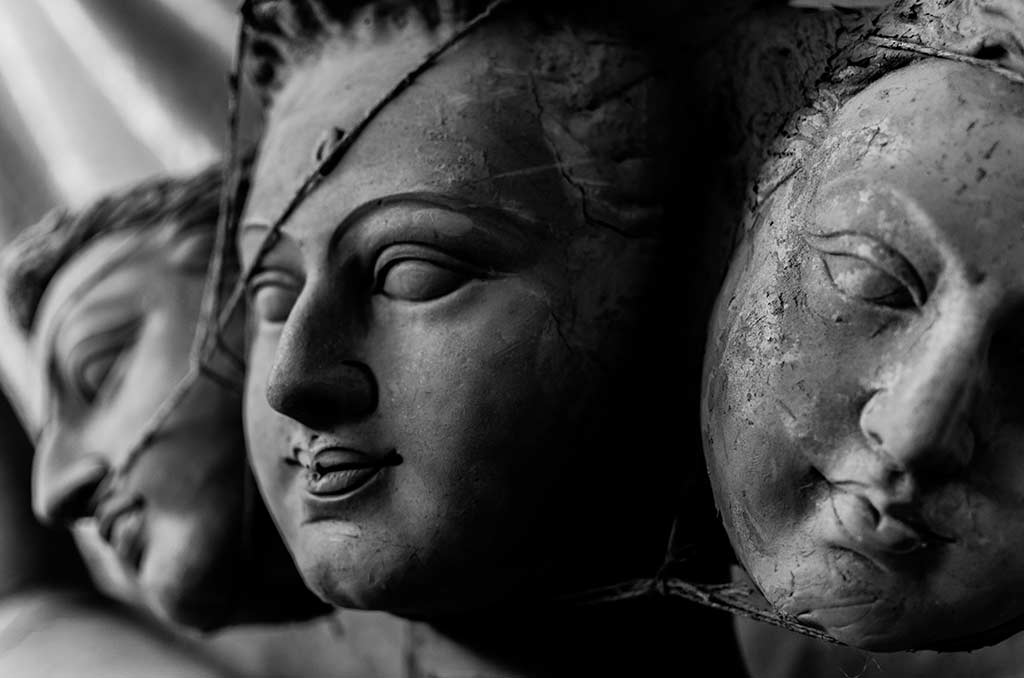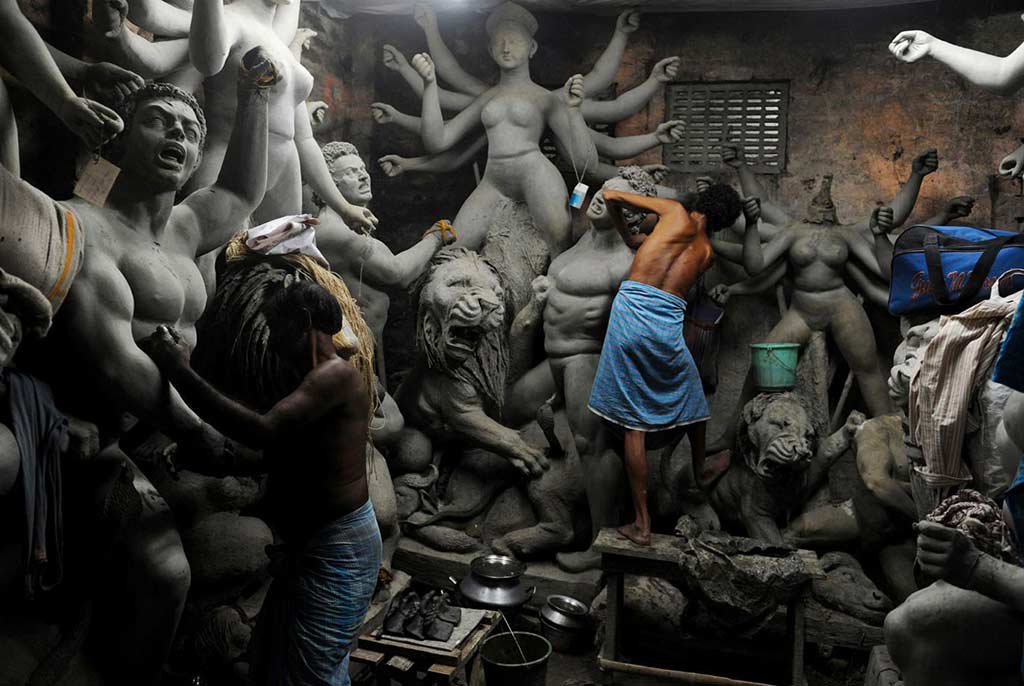Heart of Clay
From the ‘abode of the Godmakers’, the distinctive characteristic of the soil used in idol-making is more than just raw material; it is an amalgam of an ancient history that the earth holds
Suzanne McNeill
Dispersed among the outdoor restaurants, furniture showrooms and kids’ resorts that line Chennai’s south-bound East Coast Road are several garden centres. I found one I liked and visited often, drawn by the range of plants that at home I know as houseplants but which in tropical Chennai grow abundantly outside. Marshalled into strict rows were great swathes of purple bougainvillea, ornamental figs, coral-coloured anthurium and great stripy-leaved Dracaena, all planted up in the same dark red soil characteristic of this part of Tamil Nadu. The quality of that soil puzzled me.At home we fuss enormously about the structure of our garden soil, about feeding it, aerating it, tending its pH levels. This stuff was like planting in thick mud, yet everything thrived in it, even the Italian basil seeds I brought from home and germinated and grew on my balcony.
That red soil is characteristic of much of South and Northeast India, formed from the weathering of rocks high in iron oxide. Twentieth century soil studies have classified India’s soils into eight major types: laterite, mountain and desert, black and red, alluvial, saline and peat, though, as in so many areas of Indian life, soils had been codified in much earlier times and their 12 types written down in a fourth century CE Sanskrit lexicon called the Amara Kosha. These categories included fertile (urvara), barren (usara), muddy (pankila) and grassy (sadvala). Other types are poetic in their classification: sarkara was ‘land full of pebbles and pieces of limestone’, whilst nadimatrika was ‘land watered from a river’.

This taxonomy naturally emphasised the suitability of the soil to produce plants and crops, but India’s craftsmen have also exploited the qualities of the soils distinct to their regions for centuries. In Chettinad, the same red sandy soils as from the northern region of the state are collected, sieved and ground to create the area’s famous Athangudi encaustic tiles. The finish of Bidriware metalwork from Karnataka depends on a coating made from the black soil found at the base of the ancient buildings inside the city fort of Bidri. This soil has not been exposed to rain or sunlight for centuries, and contains chemicals that give the lustrous black colour unique to Bidriware. In Rajasthan, dabu is a hand-block, textile printing technique that uses a paste of local soil, gum and lime as a dye-resist in order to create patterns.
Then there’s terracotta – ‘baked earth’. Today, there are more craftsmen working with terracotta in India than anywhere else in the world. Essentially clay that has been shaped, dried and fired in a kiln, terracotta has been used for millennia to create everything from common earthen pots for water storage to roof tiles, lamps, bowls, cups, toys and even religious ritual. But clay is used in many ways, not just as the raw material for terracotta. It forms the moulds for metal casting, such as West Bengal’s Bastar Dhokra brass work and the bell metal work of Madhya Pradesh. The Mughals ornamented the walls, pillars and ceilings of their palaces with clay mouldings decorated with gold lacquer work. It was even used as a hair-mask in ancient times!
Kolkata’s 300-year-old Kumartuli neighbourhood has long been associated with the tradition of making clay pots, toys and cooking utensils. Located on the banks of the River Hooghly, it is an area of narrow lanes and busy workshops, which act as the artisans’ working space, storage areas, shops and residences. The neighbourhood has a second sobriquet, ‘the Abode of the Godmakers’, for over the years the artisans have come to specialise in making images of the deities for festivals, particularly life-size, clay idols of the Goddess Durga for Bengal’s most important festival, Durga Puja.
Traditionally, several kinds of soil were collected from around the region and mixed to make the clay for the idols, part of a religious tradition that celebrates the manifestation of Durga as creative energy and material present throughout the universe. Nowadays, the clay used by the sculptors comes from the riverbank of the Hooghly, sometimes the Ganges, and is mixed with locally sourced secondary materials. A special smooth, soft variety of clay is, however, reserved for the face, hands and embellishments.
One curious ritual is still followed, at least in some of the workshops, which is the inclusion of a lump of soil that has been scooped from the threshold of a brothel. This is believed to sanctify the mixture – the customers have left their purity at the door – and the locality from which the lump was drawn.

Work on the figures begins months in advance of the festivities. The idol is made in three stages in a process that is largely unchanged since the 17th century: the construction of a bamboo framework or armature around which to build the basic shape of the effigy, the application of clay and the decoration of the image. The figure is fashioned from cut straw, densely packed and bound by twine to create the shapes of the body and limbs.Then the structure is given its first coating: a layer of sticky clay that has been mixed with fine jute fibres or rice husks and thoroughly kneaded, using the feet, is applied. The idol is left to dry and any cracks that appear are smoothed over and layered again with the sticky clay. This is followed by a second application of finer clay, which gives the figure its smooth roundness and plastic finish.
The fine detailing of face and hands is done separately. A mould is used to create a mask for the face, which is attached to the figure’s neck. Each finger is modelled manually; the palm may be cast in a mould and then united with the fingers to create expressive hand gestures, such as a blessing, or curled to hold a spear, and attached to the goddess’s eight arms. Finally, cotton fabric dipped in clay is applied all over the figure to form a final layer, and it is released from the armature.
Decorating the idol begins with a base coat, usually a layer of tamarind seed paste and water-soluble white paint. The body colouring can be flesh colour, golden yellow or iridescent pearl; and the paint is sprayed all over the idol using a spray gun, followed by a layer of varnish.
Then with the steady hand and skill of a make-up artist, the delicate detailing to the face – the eyes, lashes, eyebrows, lips – is added. Once, the painting of the eye, an auspicious ritual that marked the symbolic awakening of the icon, would have been done only on Mahalaya, the day on which Durga is believed to have descended to earth and which marks the beginning of the Durga Puja festivities. Given the thousands of idols created in the workshops, nowadays this is completed as required.
She is worshipped every day during the festival and on the tenth and final day, she is ceremoniously paraded through the streets, accompanied by chanting and ritual drumbeats. The goddess is carried to the river, laid on her back and gently immersed in the water to dissolve and merge back with the clay of the riverbed, representing the symbolic cycle of life – what comes from the earth is but a temporary image of the body, which dissolves and loses its form to merge and mingle with its essence of impermanence in permanence once again.
Share